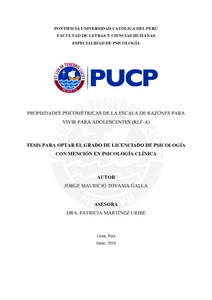Propiedades psicométricas de la Escala de Razones para Vivir para Adolescentes (RLF-A)
Abstract
El presente estudio analiza las propiedades psicométricas de la Escala de Razones Para Vivir
Para Adolescentes (RFL-A) en 486 adolescentes, de ambos sexos, estudiantes de un colegio
privado de Lima Metropolitana, cuyas edades oscilaron entre los 13 y los 17 años. Se aplicó el
RFL-A de Osman y colaboradores (1998), además de la Escala de Satisfacción con la Vida
(SWLS), el Test de Orientación Vital Revisado (LOT-R) y la Escala de Depresión Adolescente
de Reynolds (RADS) para examinar la validez convergente y divergente de la escala. Los
resultados mostraron una estructura factorial de cinco áreas idéntica al estudio original con un
66.54% de varianza explicada. El análisis de confiabilidad mostró una elevada consistencia
interna con coeficientes alfa de Cronbach en un rango de .87 a .92 para las cinco áreas y de .93
para el total de la prueba. Las correlaciones del RFL-A con el SWLS y el área de Optimismo
del LOT-R resultaron significativas y positivas, mientras que con el RADS resultaron
significativas e inversas. Con ello, se confirma que el RFL-A es un instrumento con
propiedades psicométricas adecuadas para identificar y evaluar las razones para vivir en
adolescentes, y de forma indirecta evaluar la presencia del riesgo suicida. The present study focuses on the psychometric properties of the Reasons for Living Inventory
for Adolescents (RFL-A) in 486 students from a private school in Lima, Peru, whose ages
fluctuate between 13 and 17 years old. The instruments used to determine the convergent and
divergent validity of the RFL-A of Osman et al. (1998) were the Satisfaction with Life Scale
(SWLS), the Life Orientation Test-Revisited (LOT-R) and Reynolds’ Adolescent Depression
Scale. Results from the factorial analysis reveal a 5-dimensional structure similar to the original
study with a 66.54% of explained variation. In addition, the reliability analysis shows a high
internal consistency with Cronbach’s coefficients ranging from .87 to .92 for the five areas and
.93 for the whole scale. Significant correlations of the RFL-A with SWLS, Optimism from the
LOT-R and RADS were found, these correlations were positive for the first two and negative
for the last one. Therefore, this study confirms that the RFL-A possesses good psychometric
properties, thus it is a viable instrument to identify and assess protective factors against suicide
in adolescents, and to indirectly assess the presence of suicide risk.
Temas
Adolescentes--Salud mental
Depresión mental
Satisfacción
Pruebas psicológicas
Depresión mental
Satisfacción
Pruebas psicológicas
Para optar el título de
Licenciado en Psicología Clínica
Collections
The following license files are associated with this item:






